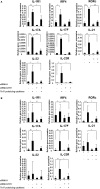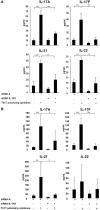Activated IL-1RI Signaling Pathway Induces Th17 Cell Differentiation via Interferon Regulatory Factor 4 Signaling in Patients with Relapsing-Remitting Multiple Sclerosis
- PMID: 27965670
- PMCID: PMC5126112
- DOI: 10.3389/fimmu.2016.00543
Activated IL-1RI Signaling Pathway Induces Th17 Cell Differentiation via Interferon Regulatory Factor 4 Signaling in Patients with Relapsing-Remitting Multiple Sclerosis
Abstract
IL-1β plays a crucial role in the differentiation of human Th17 cells. We report here that IL-1RI expression is significantly increased in both naive and memory CD4+ T cells derived from relapsing-remitting multiple sclerosis (RR MS) patients in comparison to healthy controls. Interleukin 1 receptor (IL-1R)I expression is upregulated in the in vitro-differentiated Th17 cells from RR MS patients in comparison to the Th1 and Th2 cell subsets, indicating the role of IL-1R signaling in the Th17 cell differentiation in RR MS. When IL-1RI gene expression was silenced using siRNA, human naive CD4+ T cells cultured in the presence of Th17-polarizing cytokines had a significantly decreased expression of interleukin regulatory factor 4 (IRF4), RORc, IL-17A, IL-17F, IL-21, IL-22, and IL-23R genes, confirming that IL-1RI signaling induces Th17 cell differentiation. Since IL-1R gene expression silencing inhibited IRF4 expression and Th17 differentiation, and IRF4 gene expression silencing inhibited Th17 cell differentiation, our results indicate that IL-1RI induces human Th17 cell differentiation in an IRF4-dependant manner. Our study has identified that IL-1RI-mediated signaling pathway is constitutively activated, leading to an increased Th17 cell differentiation in IRF4-dependent manner in patients with RR MS.
Keywords: IL-1; IL-1R; IRF4; Th17 cells; multiple sclerosis.
Figures






Similar articles
-
Simvastatin inhibits IFN regulatory factor 4 expression and Th17 cell differentiation in CD4+ T cells derived from patients with multiple sclerosis.J Immunol. 2011 Sep 15;187(6):3431-7. doi: 10.4049/jimmunol.1100580. Epub 2011 Aug 19. J Immunol. 2011. PMID: 21856936
-
IFN-beta inhibits human Th17 cell differentiation.J Immunol. 2009 Oct 15;183(8):5418-27. doi: 10.4049/jimmunol.0803227. Epub 2009 Sep 25. J Immunol. 2009. PMID: 19783688
-
Regulating human Th17 cells via differential expression of IL-1 receptor.Blood. 2010 Jan 21;115(3):530-40. doi: 10.1182/blood-2009-08-236521. Epub 2009 Nov 12. Blood. 2010. PMID: 19965648 Free PMC article.
-
Interferon beta inhibits the Th17 cell-mediated autoimmune response in patients with relapsing-remitting multiple sclerosis.Clin Neurol Neurosurg. 2010 Sep;112(7):641-5. doi: 10.1016/j.clineuro.2010.04.020. Epub 2010 Jun 1. Clin Neurol Neurosurg. 2010. PMID: 20570038 Review.
-
Interferon-beta inhibits Th17 cell differentiation in patients with multiple sclerosis.Endocr Metab Immune Disord Drug Targets. 2010 Jun;10(2):161-7. doi: 10.2174/187153010791213029. Endocr Metab Immune Disord Drug Targets. 2010. PMID: 20384573 Review.
Cited by
-
Bystander CD4+ T cells: crossroads between innate and adaptive immunity.Exp Mol Med. 2020 Aug;52(8):1255-1263. doi: 10.1038/s12276-020-00486-7. Epub 2020 Aug 28. Exp Mol Med. 2020. PMID: 32859954 Free PMC article. Review.
-
Induction of Unique STAT Heterodimers by IL-21 Provokes IL-1RI Expression on CD8+ T Cells, Resulting in Enhanced IL-1β Dependent Effector Function.Immune Netw. 2021 Aug 30;21(5):e33. doi: 10.4110/in.2021.21.e33. eCollection 2021 Oct. Immune Netw. 2021. PMID: 34796037 Free PMC article.
-
IL-1 Receptor Dynamics in Immune Cells: Orchestrating Immune Precision and Balance.Immune Netw. 2024 May 29;24(3):e21. doi: 10.4110/in.2024.24.e21. eCollection 2024 Jun. Immune Netw. 2024. PMID: 38974214 Free PMC article. Review.
-
The P2X7 Receptor Is Shed Into Circulation: Correlation With C-Reactive Protein Levels.Front Immunol. 2019 Apr 12;10:793. doi: 10.3389/fimmu.2019.00793. eCollection 2019. Front Immunol. 2019. PMID: 31031771 Free PMC article.
-
Could the Heat Shock Proteins 70 Family Members Exacerbate the Immune Response in Multiple Sclerosis? An in Silico Study.Genes (Basel). 2020 Jun 3;11(6):615. doi: 10.3390/genes11060615. Genes (Basel). 2020. PMID: 32503176 Free PMC article.
References
LinkOut - more resources
Full Text Sources
Other Literature Sources
Research Materials

